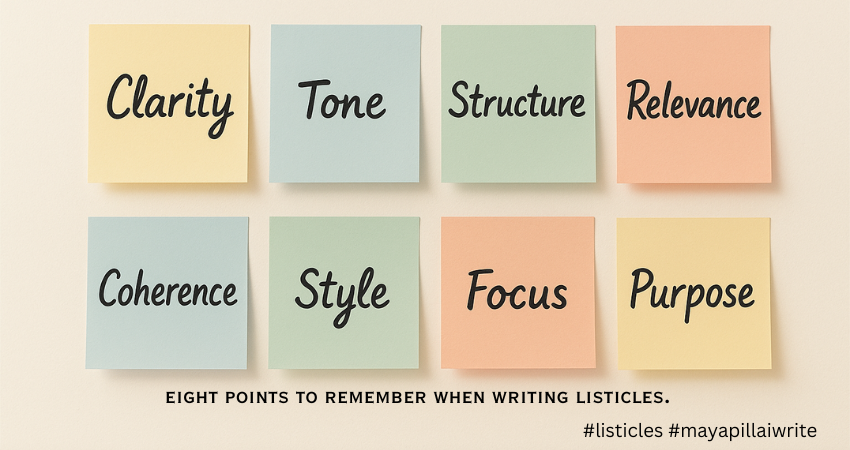Listicles are everywhere. From lifestyle blogs to business websites, they’ve become one of the most consumed formats online. They work because they’re quick to read, easy to scan, and neatly organized. If you’re new to listicles, it helps to start with the basics — what a listicle really is.
Table of Contents
ToggleBut even though the format is simple, not every listicle succeeds. Some feel repetitive, some lack structure, and others just don’t deliver on the promise in their title. The truth is, it’s not hard to make a listicle work — it’s just easy to do it wrong.
Here’s what you should avoid writing if you want your listicles to stand out for the right reasons.

TLDR
Don’t write vague, repetitive, or irrelevant points. Avoid clickbait titles, long paragraphs, and weak endings. A strong listicle is clear, specific, structured, and adds unique value to the reader.
8 Things to Remember When Writing Listicles
Listicles work best when they’re clear, structured, and add real value. Here are 8 simple things to remember when writing listicles that keep readers engaged till the end.
1. Overly Generic Points
Readers come for insights, not clichés. Lines like “Stay motivated” or “Work hard” don’t add value. Instead, focus on specific, actionable advice.
For example, if you’re writing about productivity, replace “Stay focused” with “Use the Pomodoro technique to manage distractions.” Concrete examples help readers take action.
If you’re still shaping your ideas, start by choosing the right topic for your listicle. It’s the foundation that decides whether your content will resonate or feel generic.
2. Repeated Ideas
Writers often repeat the same idea just to hit a certain number of points. If “Set goals” and “Make a plan” mean the same thing, merge them. It’s better to have 7 solid, distinct points than 12 that overlap.
The strength of a listicle lies in variety. Every point should add something new to the conversation, giving the reader a reason to keep scrolling.
3. Clickbait Promises
Headlines like “10 Proven Ways to Make $10,000 in a Week” might attract clicks, but they lose credibility fast if the content doesn’t deliver.
Readers today are smart. They expect honesty and relevance. A listicle that improves readability earns trust because it’s designed around clarity and genuine value — not empty claims.
If your title says “proven,” make sure each point includes proof, examples, or data that support it.
4. Walls of Text
One reason listicles are popular is that they make reading easy. Huge paragraphs defeat that purpose. Keep explanations short, ideally around 80–120 words.
If a point needs more detail, use sub-points or examples instead of long blocks of text. A good listicle should flow visually — quick to read, easy to scan, and pleasant to look at.
5. Irrelevant Items
Relevance is everything. Every point in your list should connect directly to your topic. If you’re writing about content strategy, don’t suddenly throw in “Get more sleep.”
Irrelevant items break the reader’s focus and weaken your authority. Before adding a point, ask: Does this directly support the title? If not, remove it.
6. Missing Structure
Consistency matters. Some writers alternate between one-line tips and full paragraphs, which creates uneven pacing.
Use a clear structure for every point:
- A short heading
- A brief explanation
- An example or takeaway
This pattern makes your writing predictable in a good way — it helps readers know what to expect and keeps them engaged.
7. No Examples or Proof
Telling readers to “write better headlines” doesn’t help unless you show how. Compare something weak like “5 Marketing Tips” to something stronger like “5 Simple Marketing Tips to Boost Conversion.”
Examples act like proof. They make your advice credible and easier to follow. Even short comparisons or real-world references can make a big difference.
For inspiration, check out why listicles work so well. It explains the psychology behind why readers love structure, clarity, and quick takeaways — the same principles you should build on.
8. Weak or Obvious Conclusions
Many writers stop abruptly with “That’s it.” That’s not an ending — it’s a pause. A good conclusion should bring the article full circle.
You could end with a short reminder like: “Every listicle you write is a promise of value. Keep it tight, keep it real, and readers will come back for more.”
This final touch helps the reader feel that they’ve completed something — not just scrolled through it.
To Sum Up
Listicles are simple, but not easy. The best ones balance clarity, consistency, and creativity. Avoid generic advice, filler content, and vague endings. If you respect your reader’s time and deliver something genuinely useful, your listicle will do more than get clicks — it will build trust.
And if you’re just starting out, you might enjoy revisiting what a listicle is and how to shape it for readability. It’s always good to return to the basics before fine-tuning your writing style.
Quick FAQs
- Why do listicles fail sometimes?
They fail when they’re repetitive, poorly structured, or overpromised. Readers can spot filler immediately. - How many points should a listicle have?
There’s no magic number, but 7–12 is ideal — long enough to add value, short enough to hold attention. - Should every point have an explanation?
Yes. A one-line list feels empty. Add two or three sentences for clarity and credibility. - Can I mix serious and fun points in one listicle?
Sure, as long as the tone fits your audience. Keep the mix intentional, not random. - What’s the best way to end a listicle?
Wrap it up with a key takeaway or reflection that reminds readers what they’ve learned. - Is humor okay in listicles?
Yes, but it should never replace substance. Use it to make your points more relatable, not to fill space. - How do I make my listicle stand out?
Focus on depth and originality. Support your points with examples, personal stories, or data others might skip.
